Comprehensive Business Report on Investment and Procurement
VerifiedAdded on 2023/06/17
|14
|3922
|162
Report
AI Summary
This business report provides a detailed analysis of capital investment appraisal, including the importance of such appraisals for businesses, preparation of cash flow analysis statements, and the analysation of the payback period. It determines the net present value (NPV) for new investments and explains the viability of investment proposals, discussing the logic behind the NPV approach and its relation to the cost of capital. The report also assesses the internal rate of return of a project and compares the net present value method with the internal rate of return technique. Furthermore, it evaluates bank finance as a long-term funding source and elaborates on different supplier categories, comparing the advantages of single and multiple sourcing in procurement, as well as the benefits of cross-sourcing. The cost volume profit analysis is also explained with its significance. Desklib offers this and many other solved assignments to help students in their studies.

BUSINESS REPORT
Paraphrase This Document
Need a fresh take? Get an instant paraphrase of this document with our AI Paraphraser
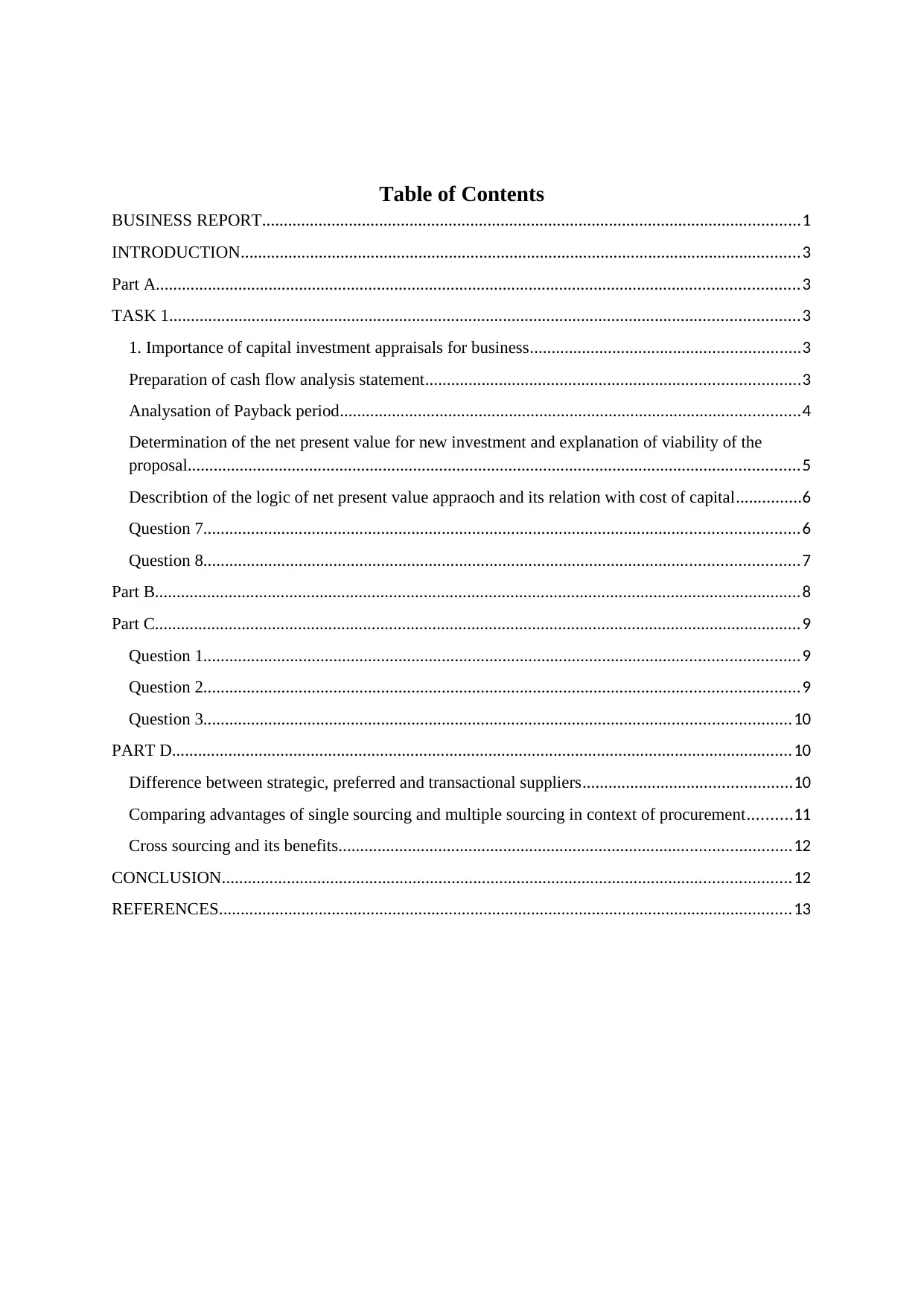
Table of Contents
BUSINESS REPORT............................................................................................................................1
INTRODUCTION.................................................................................................................................3
Part A....................................................................................................................................................3
TASK 1.................................................................................................................................................3
1. Importance of capital investment appraisals for business..............................................................3
Preparation of cash flow analysis statement......................................................................................3
Analysation of Payback period..........................................................................................................4
Determination of the net present value for new investment and explanation of viability of the
proposal.............................................................................................................................................5
Describtion of the logic of net present value appraoch and its relation with cost of capital...............6
Question 7.........................................................................................................................................6
Question 8.........................................................................................................................................7
Part B.....................................................................................................................................................8
Part C.....................................................................................................................................................9
Question 1.........................................................................................................................................9
Question 2.........................................................................................................................................9
Question 3.......................................................................................................................................10
PART D...............................................................................................................................................10
Difference between strategic, preferred and transactional suppliers................................................10
Comparing advantages of single sourcing and multiple sourcing in context of procurement..........11
Cross sourcing and its benefits........................................................................................................12
CONCLUSION...................................................................................................................................12
REFERENCES....................................................................................................................................13
BUSINESS REPORT............................................................................................................................1
INTRODUCTION.................................................................................................................................3
Part A....................................................................................................................................................3
TASK 1.................................................................................................................................................3
1. Importance of capital investment appraisals for business..............................................................3
Preparation of cash flow analysis statement......................................................................................3
Analysation of Payback period..........................................................................................................4
Determination of the net present value for new investment and explanation of viability of the
proposal.............................................................................................................................................5
Describtion of the logic of net present value appraoch and its relation with cost of capital...............6
Question 7.........................................................................................................................................6
Question 8.........................................................................................................................................7
Part B.....................................................................................................................................................8
Part C.....................................................................................................................................................9
Question 1.........................................................................................................................................9
Question 2.........................................................................................................................................9
Question 3.......................................................................................................................................10
PART D...............................................................................................................................................10
Difference between strategic, preferred and transactional suppliers................................................10
Comparing advantages of single sourcing and multiple sourcing in context of procurement..........11
Cross sourcing and its benefits........................................................................................................12
CONCLUSION...................................................................................................................................12
REFERENCES....................................................................................................................................13
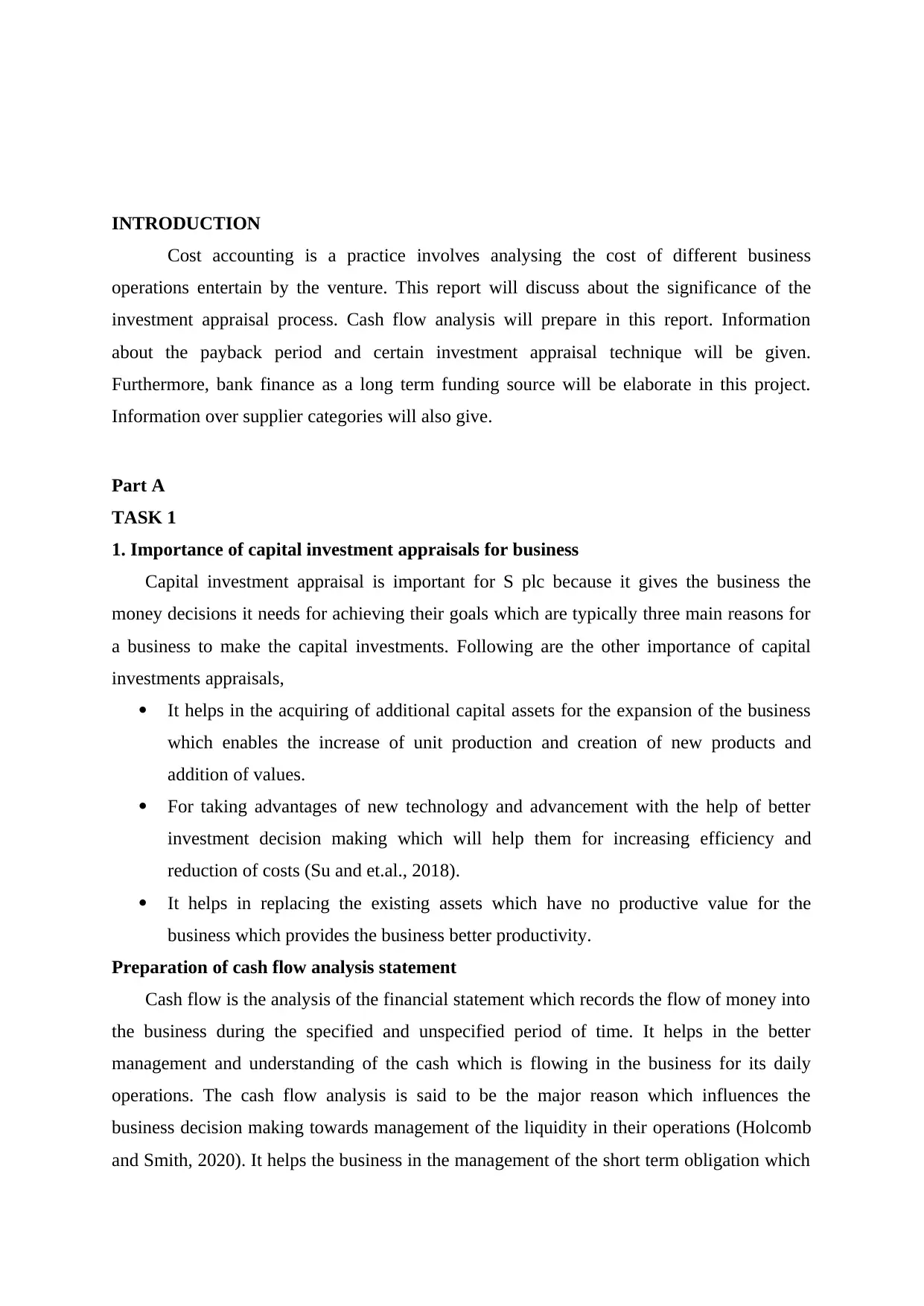
INTRODUCTION
Cost accounting is a practice involves analysing the cost of different business
operations entertain by the venture. This report will discuss about the significance of the
investment appraisal process. Cash flow analysis will prepare in this report. Information
about the payback period and certain investment appraisal technique will be given.
Furthermore, bank finance as a long term funding source will be elaborate in this project.
Information over supplier categories will also give.
Part A
TASK 1
1. Importance of capital investment appraisals for business
Capital investment appraisal is important for S plc because it gives the business the
money decisions it needs for achieving their goals which are typically three main reasons for
a business to make the capital investments. Following are the other importance of capital
investments appraisals,
It helps in the acquiring of additional capital assets for the expansion of the business
which enables the increase of unit production and creation of new products and
addition of values.
For taking advantages of new technology and advancement with the help of better
investment decision making which will help them for increasing efficiency and
reduction of costs (Su and et.al., 2018).
It helps in replacing the existing assets which have no productive value for the
business which provides the business better productivity.
Preparation of cash flow analysis statement
Cash flow is the analysis of the financial statement which records the flow of money into
the business during the specified and unspecified period of time. It helps in the better
management and understanding of the cash which is flowing in the business for its daily
operations. The cash flow analysis is said to be the major reason which influences the
business decision making towards management of the liquidity in their operations (Holcomb
and Smith, 2020). It helps the business in the management of the short term obligation which
Cost accounting is a practice involves analysing the cost of different business
operations entertain by the venture. This report will discuss about the significance of the
investment appraisal process. Cash flow analysis will prepare in this report. Information
about the payback period and certain investment appraisal technique will be given.
Furthermore, bank finance as a long term funding source will be elaborate in this project.
Information over supplier categories will also give.
Part A
TASK 1
1. Importance of capital investment appraisals for business
Capital investment appraisal is important for S plc because it gives the business the
money decisions it needs for achieving their goals which are typically three main reasons for
a business to make the capital investments. Following are the other importance of capital
investments appraisals,
It helps in the acquiring of additional capital assets for the expansion of the business
which enables the increase of unit production and creation of new products and
addition of values.
For taking advantages of new technology and advancement with the help of better
investment decision making which will help them for increasing efficiency and
reduction of costs (Su and et.al., 2018).
It helps in replacing the existing assets which have no productive value for the
business which provides the business better productivity.
Preparation of cash flow analysis statement
Cash flow is the analysis of the financial statement which records the flow of money into
the business during the specified and unspecified period of time. It helps in the better
management and understanding of the cash which is flowing in the business for its daily
operations. The cash flow analysis is said to be the major reason which influences the
business decision making towards management of the liquidity in their operations (Holcomb
and Smith, 2020). It helps the business in the management of the short term obligation which
⊘ This is a preview!⊘
Do you want full access?
Subscribe today to unlock all pages.

Trusted by 1+ million students worldwide
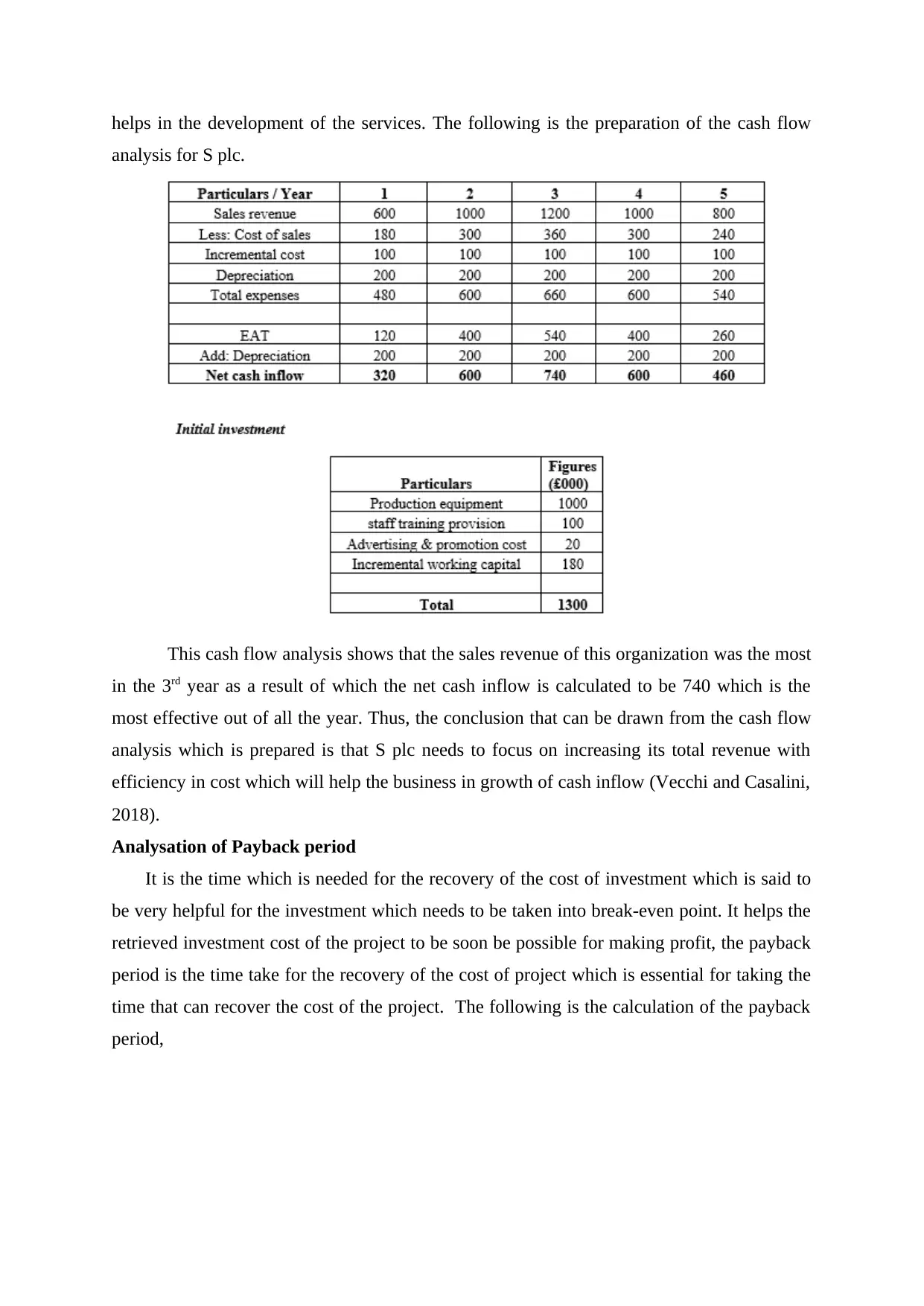
helps in the development of the services. The following is the preparation of the cash flow
analysis for S plc.
This cash flow analysis shows that the sales revenue of this organization was the most
in the 3rd year as a result of which the net cash inflow is calculated to be 740 which is the
most effective out of all the year. Thus, the conclusion that can be drawn from the cash flow
analysis which is prepared is that S plc needs to focus on increasing its total revenue with
efficiency in cost which will help the business in growth of cash inflow (Vecchi and Casalini,
2018).
Analysation of Payback period
It is the time which is needed for the recovery of the cost of investment which is said to
be very helpful for the investment which needs to be taken into break-even point. It helps the
retrieved investment cost of the project to be soon be possible for making profit, the payback
period is the time take for the recovery of the cost of project which is essential for taking the
time that can recover the cost of the project. The following is the calculation of the payback
period,
analysis for S plc.
This cash flow analysis shows that the sales revenue of this organization was the most
in the 3rd year as a result of which the net cash inflow is calculated to be 740 which is the
most effective out of all the year. Thus, the conclusion that can be drawn from the cash flow
analysis which is prepared is that S plc needs to focus on increasing its total revenue with
efficiency in cost which will help the business in growth of cash inflow (Vecchi and Casalini,
2018).
Analysation of Payback period
It is the time which is needed for the recovery of the cost of investment which is said to
be very helpful for the investment which needs to be taken into break-even point. It helps the
retrieved investment cost of the project to be soon be possible for making profit, the payback
period is the time take for the recovery of the cost of project which is essential for taking the
time that can recover the cost of the project. The following is the calculation of the payback
period,
Paraphrase This Document
Need a fresh take? Get an instant paraphrase of this document with our AI Paraphraser
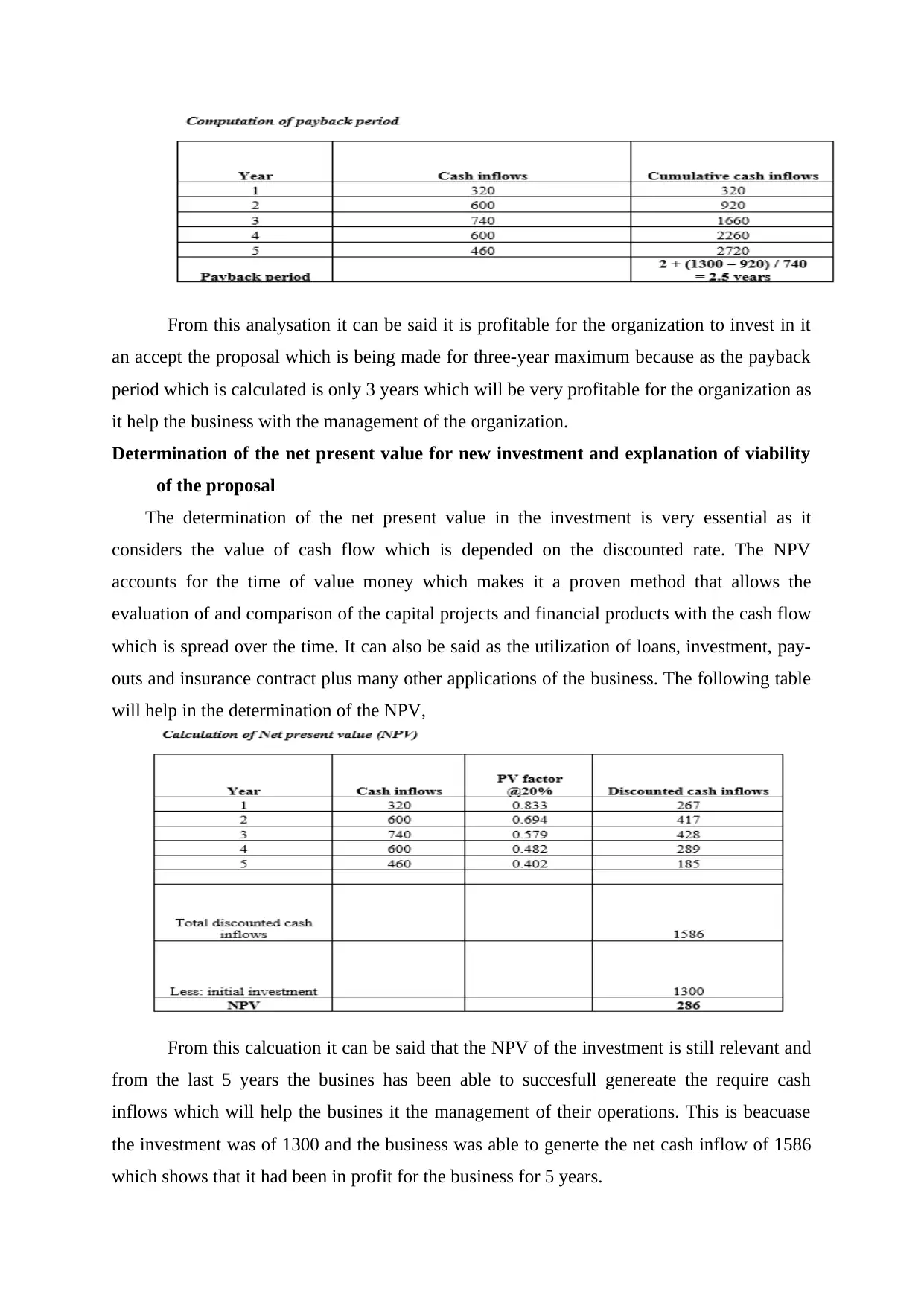
From this analysation it can be said it is profitable for the organization to invest in it
an accept the proposal which is being made for three-year maximum because as the payback
period which is calculated is only 3 years which will be very profitable for the organization as
it help the business with the management of the organization.
Determination of the net present value for new investment and explanation of viability
of the proposal
The determination of the net present value in the investment is very essential as it
considers the value of cash flow which is depended on the discounted rate. The NPV
accounts for the time of value money which makes it a proven method that allows the
evaluation of and comparison of the capital projects and financial products with the cash flow
which is spread over the time. It can also be said as the utilization of loans, investment, pay-
outs and insurance contract plus many other applications of the business. The following table
will help in the determination of the NPV,
From this calcuation it can be said that the NPV of the investment is still relevant and
from the last 5 years the busines has been able to succesfull genereate the require cash
inflows which will help the busines it the management of their operations. This is beacuase
the investment was of 1300 and the business was able to generte the net cash inflow of 1586
which shows that it had been in profit for the business for 5 years.
an accept the proposal which is being made for three-year maximum because as the payback
period which is calculated is only 3 years which will be very profitable for the organization as
it help the business with the management of the organization.
Determination of the net present value for new investment and explanation of viability
of the proposal
The determination of the net present value in the investment is very essential as it
considers the value of cash flow which is depended on the discounted rate. The NPV
accounts for the time of value money which makes it a proven method that allows the
evaluation of and comparison of the capital projects and financial products with the cash flow
which is spread over the time. It can also be said as the utilization of loans, investment, pay-
outs and insurance contract plus many other applications of the business. The following table
will help in the determination of the NPV,
From this calcuation it can be said that the NPV of the investment is still relevant and
from the last 5 years the busines has been able to succesfull genereate the require cash
inflows which will help the busines it the management of their operations. This is beacuase
the investment was of 1300 and the business was able to generte the net cash inflow of 1586
which shows that it had been in profit for the business for 5 years.
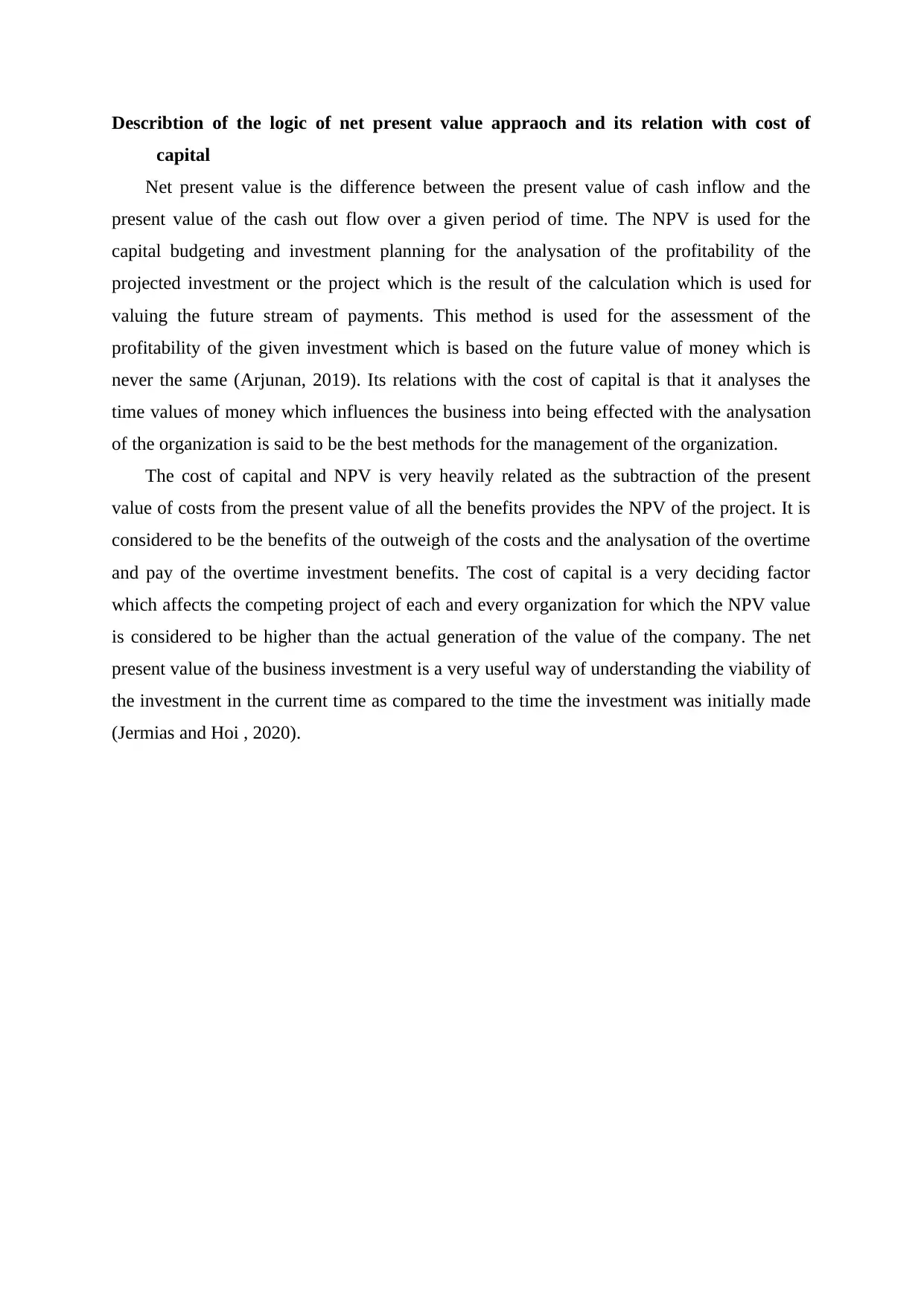
Describtion of the logic of net present value appraoch and its relation with cost of
capital
Net present value is the difference between the present value of cash inflow and the
present value of the cash out flow over a given period of time. The NPV is used for the
capital budgeting and investment planning for the analysation of the profitability of the
projected investment or the project which is the result of the calculation which is used for
valuing the future stream of payments. This method is used for the assessment of the
profitability of the given investment which is based on the future value of money which is
never the same (Arjunan, 2019). Its relations with the cost of capital is that it analyses the
time values of money which influences the business into being effected with the analysation
of the organization is said to be the best methods for the management of the organization.
The cost of capital and NPV is very heavily related as the subtraction of the present
value of costs from the present value of all the benefits provides the NPV of the project. It is
considered to be the benefits of the outweigh of the costs and the analysation of the overtime
and pay of the overtime investment benefits. The cost of capital is a very deciding factor
which affects the competing project of each and every organization for which the NPV value
is considered to be higher than the actual generation of the value of the company. The net
present value of the business investment is a very useful way of understanding the viability of
the investment in the current time as compared to the time the investment was initially made
(Jermias and Hoi , 2020).
capital
Net present value is the difference between the present value of cash inflow and the
present value of the cash out flow over a given period of time. The NPV is used for the
capital budgeting and investment planning for the analysation of the profitability of the
projected investment or the project which is the result of the calculation which is used for
valuing the future stream of payments. This method is used for the assessment of the
profitability of the given investment which is based on the future value of money which is
never the same (Arjunan, 2019). Its relations with the cost of capital is that it analyses the
time values of money which influences the business into being effected with the analysation
of the organization is said to be the best methods for the management of the organization.
The cost of capital and NPV is very heavily related as the subtraction of the present
value of costs from the present value of all the benefits provides the NPV of the project. It is
considered to be the benefits of the outweigh of the costs and the analysation of the overtime
and pay of the overtime investment benefits. The cost of capital is a very deciding factor
which affects the competing project of each and every organization for which the NPV value
is considered to be higher than the actual generation of the value of the company. The net
present value of the business investment is a very useful way of understanding the viability of
the investment in the current time as compared to the time the investment was initially made
(Jermias and Hoi , 2020).
⊘ This is a preview!⊘
Do you want full access?
Subscribe today to unlock all pages.

Trusted by 1+ million students worldwide
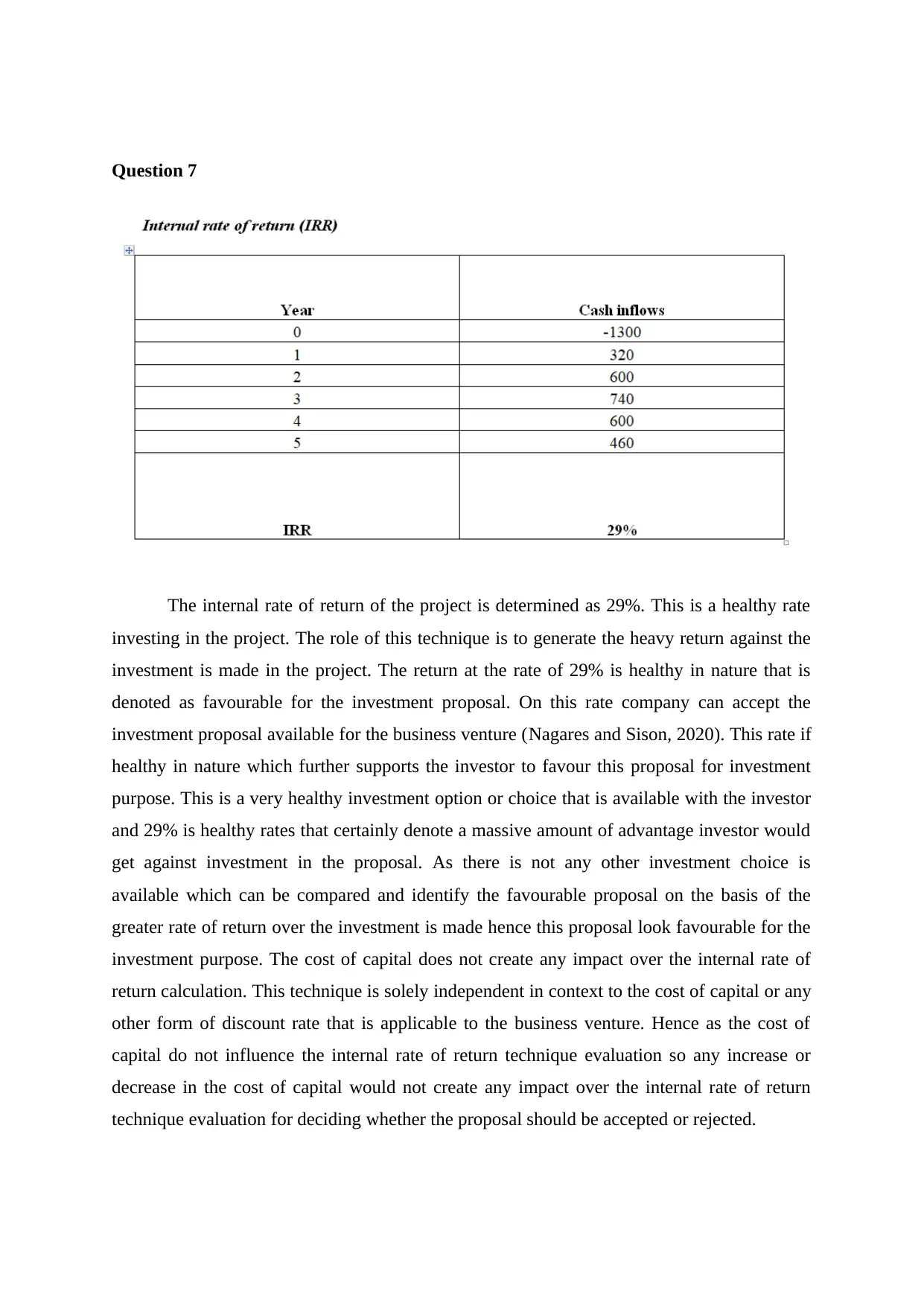
Question 7
The internal rate of return of the project is determined as 29%. This is a healthy rate
investing in the project. The role of this technique is to generate the heavy return against the
investment is made in the project. The return at the rate of 29% is healthy in nature that is
denoted as favourable for the investment proposal. On this rate company can accept the
investment proposal available for the business venture (Nagares and Sison, 2020). This rate if
healthy in nature which further supports the investor to favour this proposal for investment
purpose. This is a very healthy investment option or choice that is available with the investor
and 29% is healthy rates that certainly denote a massive amount of advantage investor would
get against investment in the proposal. As there is not any other investment choice is
available which can be compared and identify the favourable proposal on the basis of the
greater rate of return over the investment is made hence this proposal look favourable for the
investment purpose. The cost of capital does not create any impact over the internal rate of
return calculation. This technique is solely independent in context to the cost of capital or any
other form of discount rate that is applicable to the business venture. Hence as the cost of
capital do not influence the internal rate of return technique evaluation so any increase or
decrease in the cost of capital would not create any impact over the internal rate of return
technique evaluation for deciding whether the proposal should be accepted or rejected.
The internal rate of return of the project is determined as 29%. This is a healthy rate
investing in the project. The role of this technique is to generate the heavy return against the
investment is made in the project. The return at the rate of 29% is healthy in nature that is
denoted as favourable for the investment proposal. On this rate company can accept the
investment proposal available for the business venture (Nagares and Sison, 2020). This rate if
healthy in nature which further supports the investor to favour this proposal for investment
purpose. This is a very healthy investment option or choice that is available with the investor
and 29% is healthy rates that certainly denote a massive amount of advantage investor would
get against investment in the proposal. As there is not any other investment choice is
available which can be compared and identify the favourable proposal on the basis of the
greater rate of return over the investment is made hence this proposal look favourable for the
investment purpose. The cost of capital does not create any impact over the internal rate of
return calculation. This technique is solely independent in context to the cost of capital or any
other form of discount rate that is applicable to the business venture. Hence as the cost of
capital do not influence the internal rate of return technique evaluation so any increase or
decrease in the cost of capital would not create any impact over the internal rate of return
technique evaluation for deciding whether the proposal should be accepted or rejected.
Paraphrase This Document
Need a fresh take? Get an instant paraphrase of this document with our AI Paraphraser
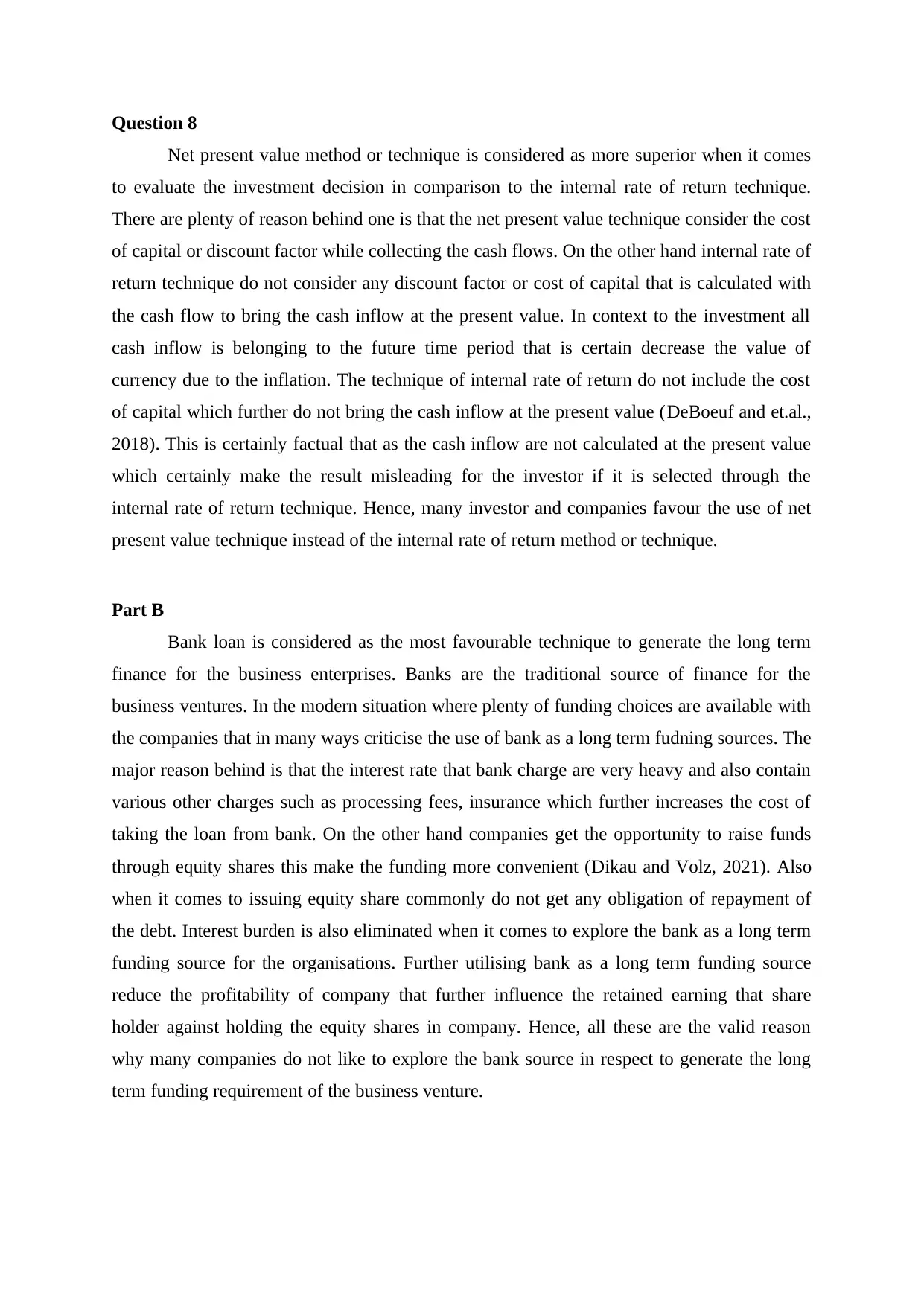
Question 8
Net present value method or technique is considered as more superior when it comes
to evaluate the investment decision in comparison to the internal rate of return technique.
There are plenty of reason behind one is that the net present value technique consider the cost
of capital or discount factor while collecting the cash flows. On the other hand internal rate of
return technique do not consider any discount factor or cost of capital that is calculated with
the cash flow to bring the cash inflow at the present value. In context to the investment all
cash inflow is belonging to the future time period that is certain decrease the value of
currency due to the inflation. The technique of internal rate of return do not include the cost
of capital which further do not bring the cash inflow at the present value (DeBoeuf and et.al.,
2018). This is certainly factual that as the cash inflow are not calculated at the present value
which certainly make the result misleading for the investor if it is selected through the
internal rate of return technique. Hence, many investor and companies favour the use of net
present value technique instead of the internal rate of return method or technique.
Part B
Bank loan is considered as the most favourable technique to generate the long term
finance for the business enterprises. Banks are the traditional source of finance for the
business ventures. In the modern situation where plenty of funding choices are available with
the companies that in many ways criticise the use of bank as a long term fudning sources. The
major reason behind is that the interest rate that bank charge are very heavy and also contain
various other charges such as processing fees, insurance which further increases the cost of
taking the loan from bank. On the other hand companies get the opportunity to raise funds
through equity shares this make the funding more convenient (Dikau and Volz, 2021). Also
when it comes to issuing equity share commonly do not get any obligation of repayment of
the debt. Interest burden is also eliminated when it comes to explore the bank as a long term
funding source for the organisations. Further utilising bank as a long term funding source
reduce the profitability of company that further influence the retained earning that share
holder against holding the equity shares in company. Hence, all these are the valid reason
why many companies do not like to explore the bank source in respect to generate the long
term funding requirement of the business venture.
Net present value method or technique is considered as more superior when it comes
to evaluate the investment decision in comparison to the internal rate of return technique.
There are plenty of reason behind one is that the net present value technique consider the cost
of capital or discount factor while collecting the cash flows. On the other hand internal rate of
return technique do not consider any discount factor or cost of capital that is calculated with
the cash flow to bring the cash inflow at the present value. In context to the investment all
cash inflow is belonging to the future time period that is certain decrease the value of
currency due to the inflation. The technique of internal rate of return do not include the cost
of capital which further do not bring the cash inflow at the present value (DeBoeuf and et.al.,
2018). This is certainly factual that as the cash inflow are not calculated at the present value
which certainly make the result misleading for the investor if it is selected through the
internal rate of return technique. Hence, many investor and companies favour the use of net
present value technique instead of the internal rate of return method or technique.
Part B
Bank loan is considered as the most favourable technique to generate the long term
finance for the business enterprises. Banks are the traditional source of finance for the
business ventures. In the modern situation where plenty of funding choices are available with
the companies that in many ways criticise the use of bank as a long term fudning sources. The
major reason behind is that the interest rate that bank charge are very heavy and also contain
various other charges such as processing fees, insurance which further increases the cost of
taking the loan from bank. On the other hand companies get the opportunity to raise funds
through equity shares this make the funding more convenient (Dikau and Volz, 2021). Also
when it comes to issuing equity share commonly do not get any obligation of repayment of
the debt. Interest burden is also eliminated when it comes to explore the bank as a long term
funding source for the organisations. Further utilising bank as a long term funding source
reduce the profitability of company that further influence the retained earning that share
holder against holding the equity shares in company. Hence, all these are the valid reason
why many companies do not like to explore the bank source in respect to generate the long
term funding requirement of the business venture.
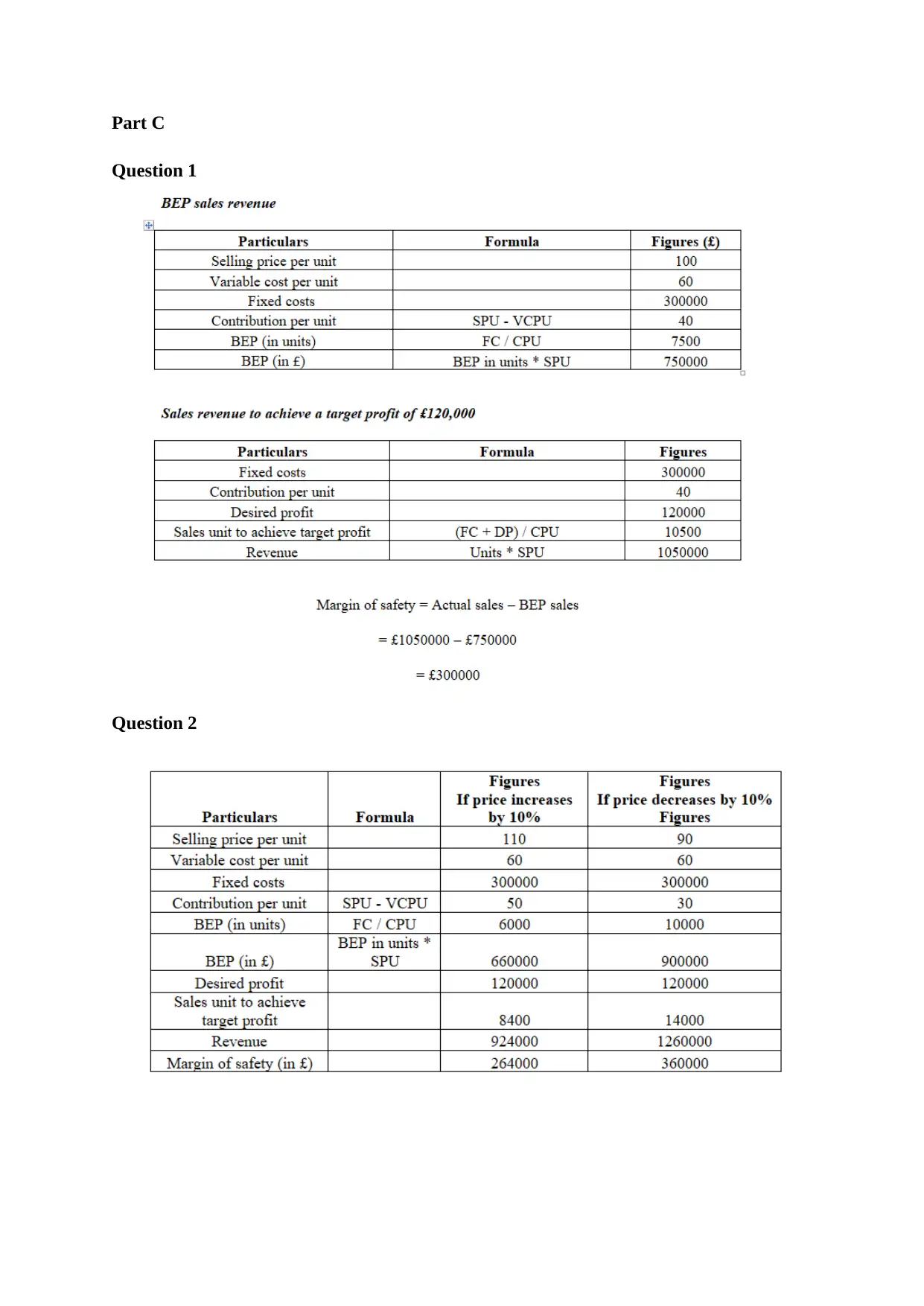
Part C
Question 1
Question 2
Question 1
Question 2
⊘ This is a preview!⊘
Do you want full access?
Subscribe today to unlock all pages.

Trusted by 1+ million students worldwide
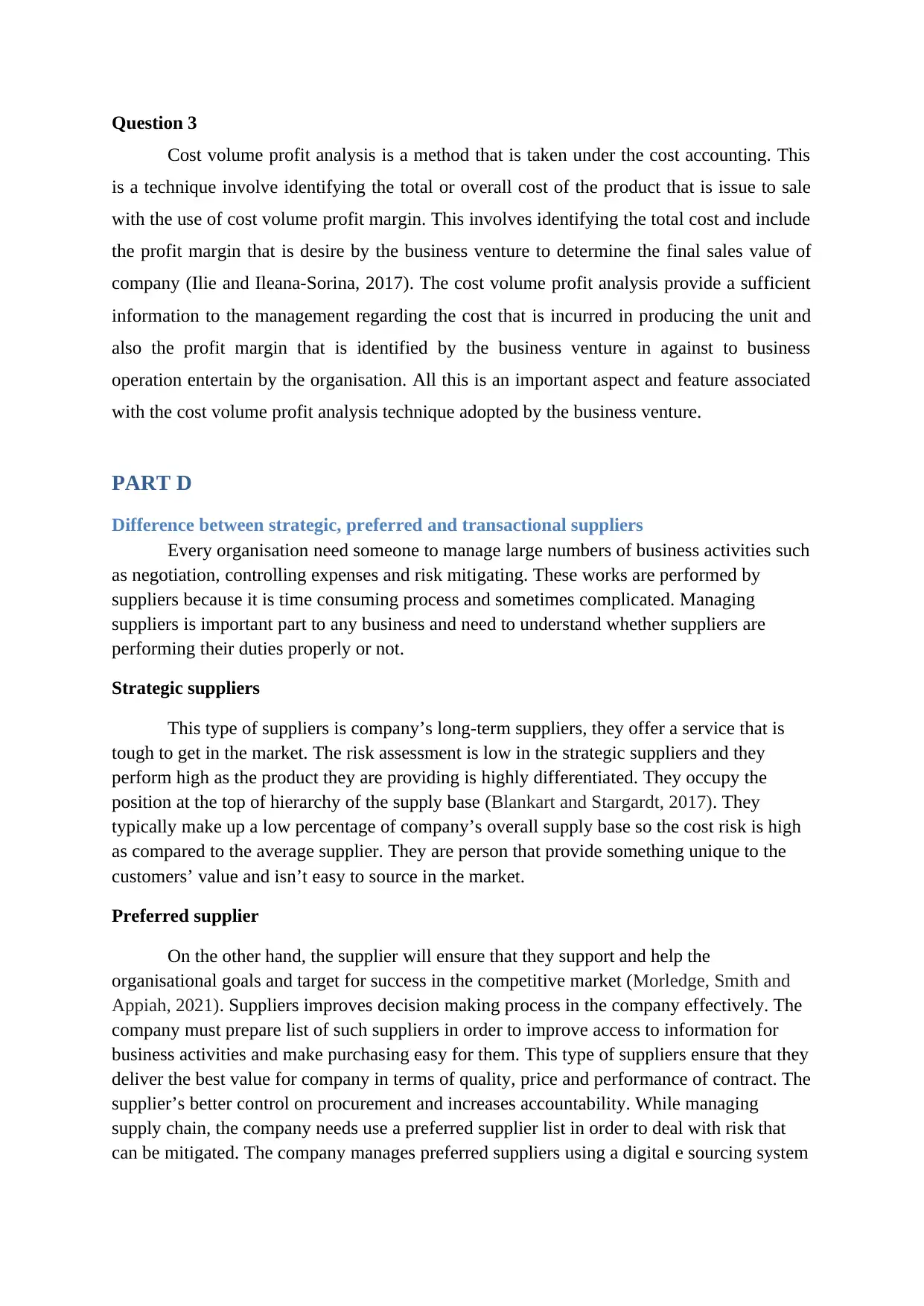
Question 3
Cost volume profit analysis is a method that is taken under the cost accounting. This
is a technique involve identifying the total or overall cost of the product that is issue to sale
with the use of cost volume profit margin. This involves identifying the total cost and include
the profit margin that is desire by the business venture to determine the final sales value of
company (Ilie and Ileana-Sorina, 2017). The cost volume profit analysis provide a sufficient
information to the management regarding the cost that is incurred in producing the unit and
also the profit margin that is identified by the business venture in against to business
operation entertain by the organisation. All this is an important aspect and feature associated
with the cost volume profit analysis technique adopted by the business venture.
PART D
Difference between strategic, preferred and transactional suppliers
Every organisation need someone to manage large numbers of business activities such
as negotiation, controlling expenses and risk mitigating. These works are performed by
suppliers because it is time consuming process and sometimes complicated. Managing
suppliers is important part to any business and need to understand whether suppliers are
performing their duties properly or not.
Strategic suppliers
This type of suppliers is company’s long-term suppliers, they offer a service that is
tough to get in the market. The risk assessment is low in the strategic suppliers and they
perform high as the product they are providing is highly differentiated. They occupy the
position at the top of hierarchy of the supply base (Blankart and Stargardt, 2017). They
typically make up a low percentage of company’s overall supply base so the cost risk is high
as compared to the average supplier. They are person that provide something unique to the
customers’ value and isn’t easy to source in the market.
Preferred supplier
On the other hand, the supplier will ensure that they support and help the
organisational goals and target for success in the competitive market (Morledge, Smith and
Appiah, 2021). Suppliers improves decision making process in the company effectively. The
company must prepare list of such suppliers in order to improve access to information for
business activities and make purchasing easy for them. This type of suppliers ensure that they
deliver the best value for company in terms of quality, price and performance of contract. The
supplier’s better control on procurement and increases accountability. While managing
supply chain, the company needs use a preferred supplier list in order to deal with risk that
can be mitigated. The company manages preferred suppliers using a digital e sourcing system
Cost volume profit analysis is a method that is taken under the cost accounting. This
is a technique involve identifying the total or overall cost of the product that is issue to sale
with the use of cost volume profit margin. This involves identifying the total cost and include
the profit margin that is desire by the business venture to determine the final sales value of
company (Ilie and Ileana-Sorina, 2017). The cost volume profit analysis provide a sufficient
information to the management regarding the cost that is incurred in producing the unit and
also the profit margin that is identified by the business venture in against to business
operation entertain by the organisation. All this is an important aspect and feature associated
with the cost volume profit analysis technique adopted by the business venture.
PART D
Difference between strategic, preferred and transactional suppliers
Every organisation need someone to manage large numbers of business activities such
as negotiation, controlling expenses and risk mitigating. These works are performed by
suppliers because it is time consuming process and sometimes complicated. Managing
suppliers is important part to any business and need to understand whether suppliers are
performing their duties properly or not.
Strategic suppliers
This type of suppliers is company’s long-term suppliers, they offer a service that is
tough to get in the market. The risk assessment is low in the strategic suppliers and they
perform high as the product they are providing is highly differentiated. They occupy the
position at the top of hierarchy of the supply base (Blankart and Stargardt, 2017). They
typically make up a low percentage of company’s overall supply base so the cost risk is high
as compared to the average supplier. They are person that provide something unique to the
customers’ value and isn’t easy to source in the market.
Preferred supplier
On the other hand, the supplier will ensure that they support and help the
organisational goals and target for success in the competitive market (Morledge, Smith and
Appiah, 2021). Suppliers improves decision making process in the company effectively. The
company must prepare list of such suppliers in order to improve access to information for
business activities and make purchasing easy for them. This type of suppliers ensure that they
deliver the best value for company in terms of quality, price and performance of contract. The
supplier’s better control on procurement and increases accountability. While managing
supply chain, the company needs use a preferred supplier list in order to deal with risk that
can be mitigated. The company manages preferred suppliers using a digital e sourcing system
Paraphrase This Document
Need a fresh take? Get an instant paraphrase of this document with our AI Paraphraser
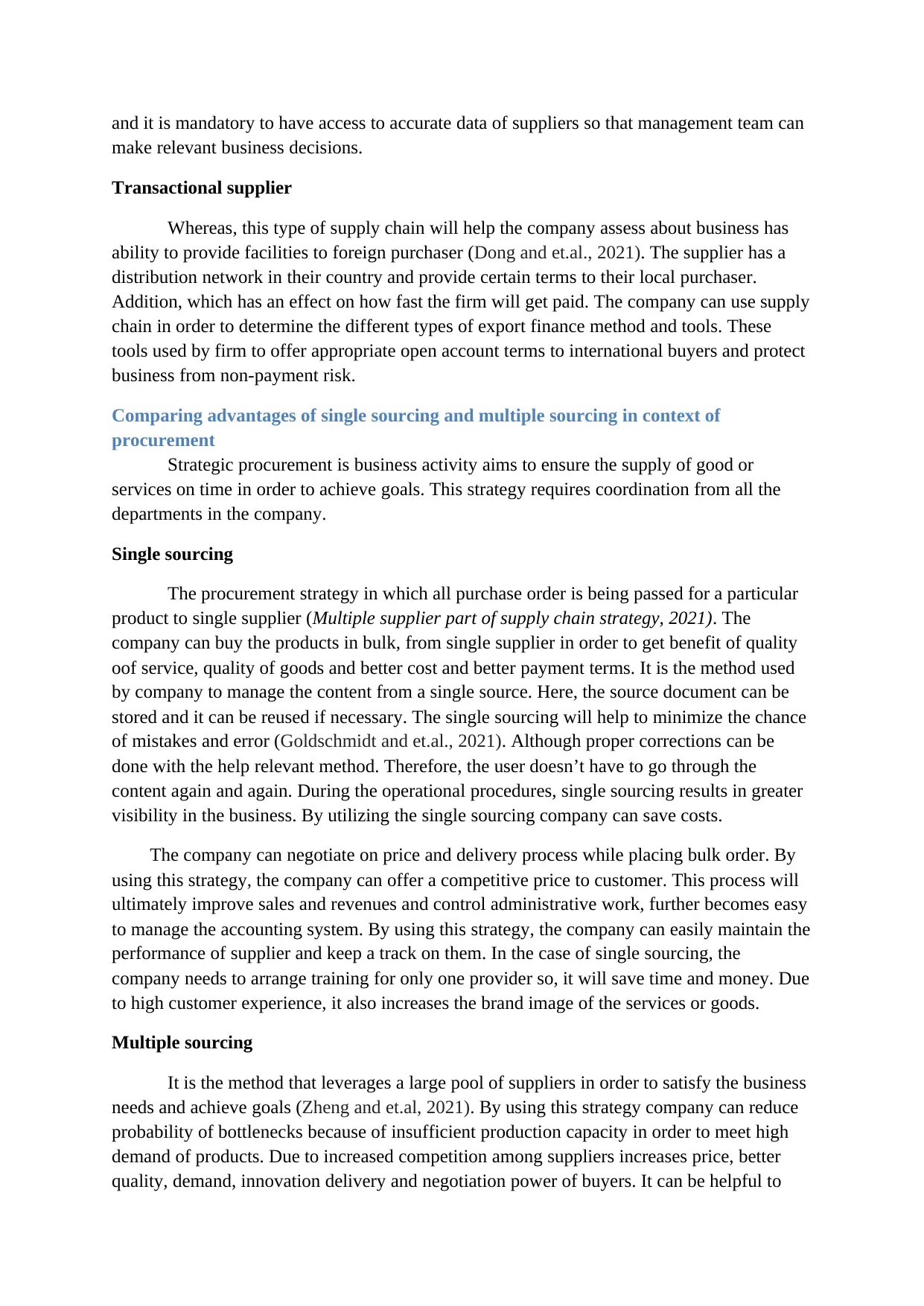
and it is mandatory to have access to accurate data of suppliers so that management team can
make relevant business decisions.
Transactional supplier
Whereas, this type of supply chain will help the company assess about business has
ability to provide facilities to foreign purchaser (Dong and et.al., 2021). The supplier has a
distribution network in their country and provide certain terms to their local purchaser.
Addition, which has an effect on how fast the firm will get paid. The company can use supply
chain in order to determine the different types of export finance method and tools. These
tools used by firm to offer appropriate open account terms to international buyers and protect
business from non-payment risk.
Comparing advantages of single sourcing and multiple sourcing in context of
procurement
Strategic procurement is business activity aims to ensure the supply of good or
services on time in order to achieve goals. This strategy requires coordination from all the
departments in the company.
Single sourcing
The procurement strategy in which all purchase order is being passed for a particular
product to single supplier (Multiple supplier part of supply chain strategy, 2021). The
company can buy the products in bulk, from single supplier in order to get benefit of quality
oof service, quality of goods and better cost and better payment terms. It is the method used
by company to manage the content from a single source. Here, the source document can be
stored and it can be reused if necessary. The single sourcing will help to minimize the chance
of mistakes and error (Goldschmidt and et.al., 2021). Although proper corrections can be
done with the help relevant method. Therefore, the user doesn’t have to go through the
content again and again. During the operational procedures, single sourcing results in greater
visibility in the business. By utilizing the single sourcing company can save costs.
The company can negotiate on price and delivery process while placing bulk order. By
using this strategy, the company can offer a competitive price to customer. This process will
ultimately improve sales and revenues and control administrative work, further becomes easy
to manage the accounting system. By using this strategy, the company can easily maintain the
performance of supplier and keep a track on them. In the case of single sourcing, the
company needs to arrange training for only one provider so, it will save time and money. Due
to high customer experience, it also increases the brand image of the services or goods.
Multiple sourcing
It is the method that leverages a large pool of suppliers in order to satisfy the business
needs and achieve goals (Zheng and et.al, 2021). By using this strategy company can reduce
probability of bottlenecks because of insufficient production capacity in order to meet high
demand of products. Due to increased competition among suppliers increases price, better
quality, demand, innovation delivery and negotiation power of buyers. It can be helpful to
make relevant business decisions.
Transactional supplier
Whereas, this type of supply chain will help the company assess about business has
ability to provide facilities to foreign purchaser (Dong and et.al., 2021). The supplier has a
distribution network in their country and provide certain terms to their local purchaser.
Addition, which has an effect on how fast the firm will get paid. The company can use supply
chain in order to determine the different types of export finance method and tools. These
tools used by firm to offer appropriate open account terms to international buyers and protect
business from non-payment risk.
Comparing advantages of single sourcing and multiple sourcing in context of
procurement
Strategic procurement is business activity aims to ensure the supply of good or
services on time in order to achieve goals. This strategy requires coordination from all the
departments in the company.
Single sourcing
The procurement strategy in which all purchase order is being passed for a particular
product to single supplier (Multiple supplier part of supply chain strategy, 2021). The
company can buy the products in bulk, from single supplier in order to get benefit of quality
oof service, quality of goods and better cost and better payment terms. It is the method used
by company to manage the content from a single source. Here, the source document can be
stored and it can be reused if necessary. The single sourcing will help to minimize the chance
of mistakes and error (Goldschmidt and et.al., 2021). Although proper corrections can be
done with the help relevant method. Therefore, the user doesn’t have to go through the
content again and again. During the operational procedures, single sourcing results in greater
visibility in the business. By utilizing the single sourcing company can save costs.
The company can negotiate on price and delivery process while placing bulk order. By
using this strategy, the company can offer a competitive price to customer. This process will
ultimately improve sales and revenues and control administrative work, further becomes easy
to manage the accounting system. By using this strategy, the company can easily maintain the
performance of supplier and keep a track on them. In the case of single sourcing, the
company needs to arrange training for only one provider so, it will save time and money. Due
to high customer experience, it also increases the brand image of the services or goods.
Multiple sourcing
It is the method that leverages a large pool of suppliers in order to satisfy the business
needs and achieve goals (Zheng and et.al, 2021). By using this strategy company can reduce
probability of bottlenecks because of insufficient production capacity in order to meet high
demand of products. Due to increased competition among suppliers increases price, better
quality, demand, innovation delivery and negotiation power of buyers. It can be helpful to
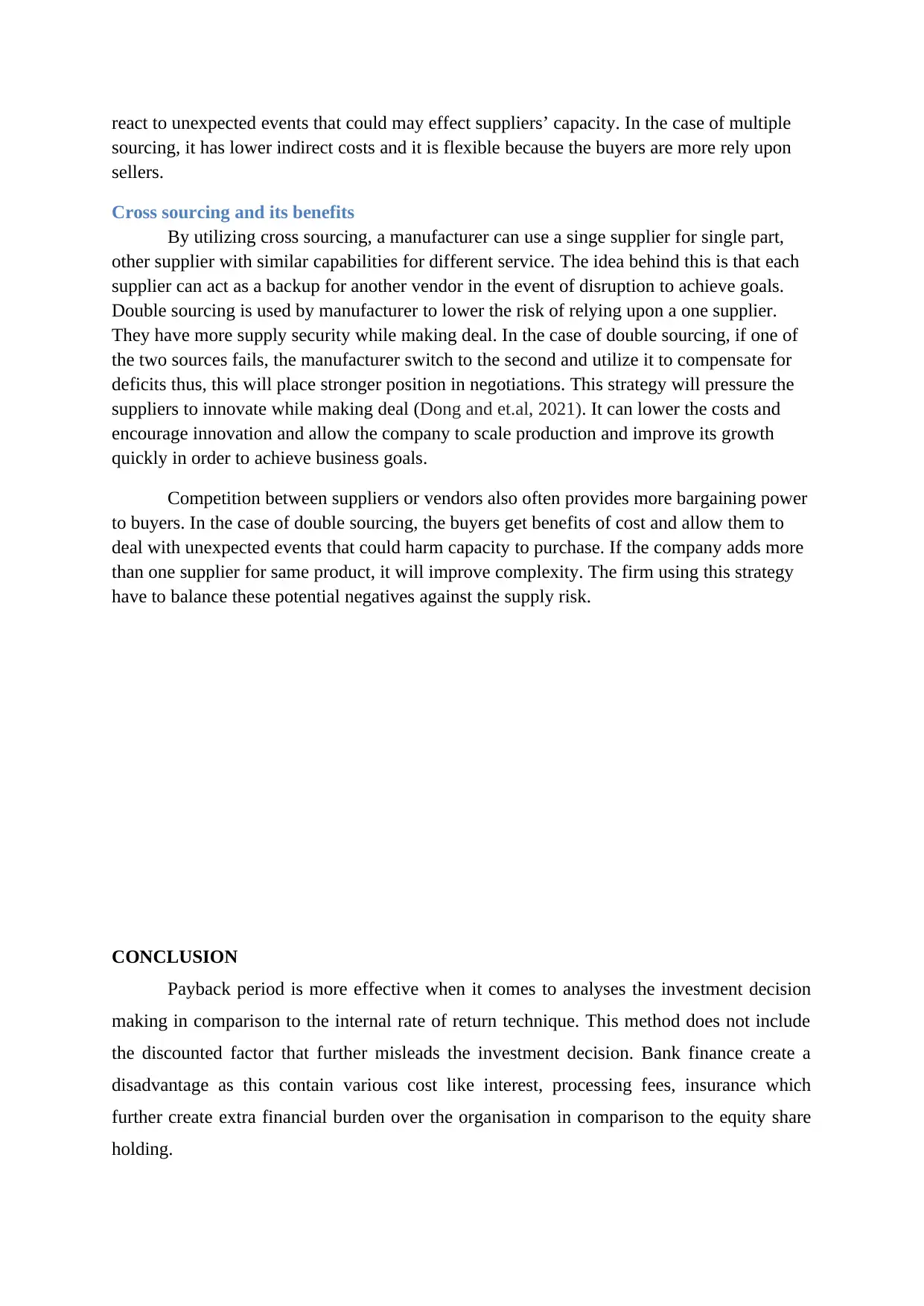
react to unexpected events that could may effect suppliers’ capacity. In the case of multiple
sourcing, it has lower indirect costs and it is flexible because the buyers are more rely upon
sellers.
Cross sourcing and its benefits
By utilizing cross sourcing, a manufacturer can use a singe supplier for single part,
other supplier with similar capabilities for different service. The idea behind this is that each
supplier can act as a backup for another vendor in the event of disruption to achieve goals.
Double sourcing is used by manufacturer to lower the risk of relying upon a one supplier.
They have more supply security while making deal. In the case of double sourcing, if one of
the two sources fails, the manufacturer switch to the second and utilize it to compensate for
deficits thus, this will place stronger position in negotiations. This strategy will pressure the
suppliers to innovate while making deal (Dong and et.al, 2021). It can lower the costs and
encourage innovation and allow the company to scale production and improve its growth
quickly in order to achieve business goals.
Competition between suppliers or vendors also often provides more bargaining power
to buyers. In the case of double sourcing, the buyers get benefits of cost and allow them to
deal with unexpected events that could harm capacity to purchase. If the company adds more
than one supplier for same product, it will improve complexity. The firm using this strategy
have to balance these potential negatives against the supply risk.
CONCLUSION
Payback period is more effective when it comes to analyses the investment decision
making in comparison to the internal rate of return technique. This method does not include
the discounted factor that further misleads the investment decision. Bank finance create a
disadvantage as this contain various cost like interest, processing fees, insurance which
further create extra financial burden over the organisation in comparison to the equity share
holding.
sourcing, it has lower indirect costs and it is flexible because the buyers are more rely upon
sellers.
Cross sourcing and its benefits
By utilizing cross sourcing, a manufacturer can use a singe supplier for single part,
other supplier with similar capabilities for different service. The idea behind this is that each
supplier can act as a backup for another vendor in the event of disruption to achieve goals.
Double sourcing is used by manufacturer to lower the risk of relying upon a one supplier.
They have more supply security while making deal. In the case of double sourcing, if one of
the two sources fails, the manufacturer switch to the second and utilize it to compensate for
deficits thus, this will place stronger position in negotiations. This strategy will pressure the
suppliers to innovate while making deal (Dong and et.al, 2021). It can lower the costs and
encourage innovation and allow the company to scale production and improve its growth
quickly in order to achieve business goals.
Competition between suppliers or vendors also often provides more bargaining power
to buyers. In the case of double sourcing, the buyers get benefits of cost and allow them to
deal with unexpected events that could harm capacity to purchase. If the company adds more
than one supplier for same product, it will improve complexity. The firm using this strategy
have to balance these potential negatives against the supply risk.
CONCLUSION
Payback period is more effective when it comes to analyses the investment decision
making in comparison to the internal rate of return technique. This method does not include
the discounted factor that further misleads the investment decision. Bank finance create a
disadvantage as this contain various cost like interest, processing fees, insurance which
further create extra financial burden over the organisation in comparison to the equity share
holding.
⊘ This is a preview!⊘
Do you want full access?
Subscribe today to unlock all pages.

Trusted by 1+ million students worldwide
1 out of 14
Related Documents
Your All-in-One AI-Powered Toolkit for Academic Success.
+13062052269
info@desklib.com
Available 24*7 on WhatsApp / Email
![[object Object]](/_next/static/media/star-bottom.7253800d.svg)
Unlock your academic potential
Copyright © 2020–2025 A2Z Services. All Rights Reserved. Developed and managed by ZUCOL.





